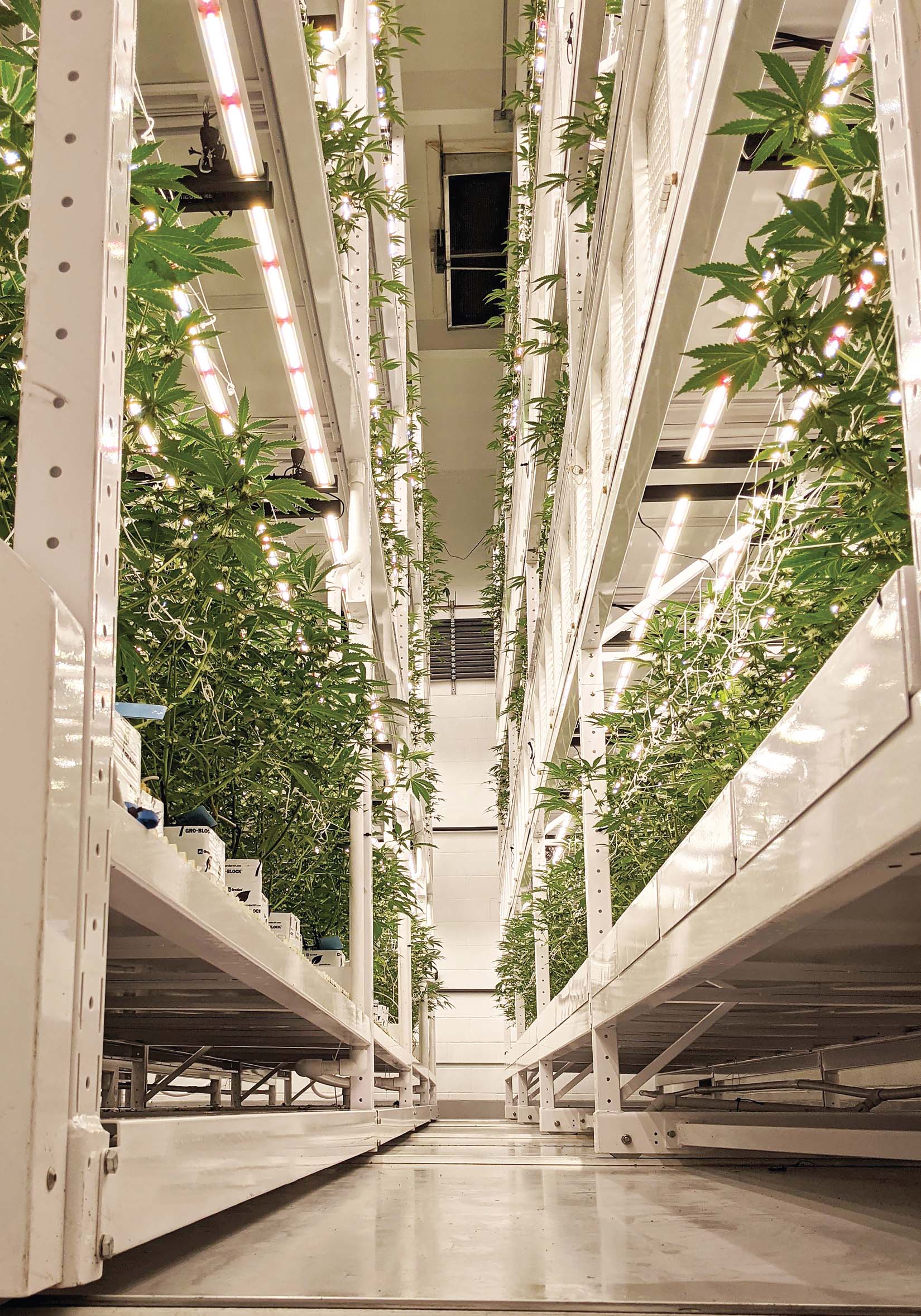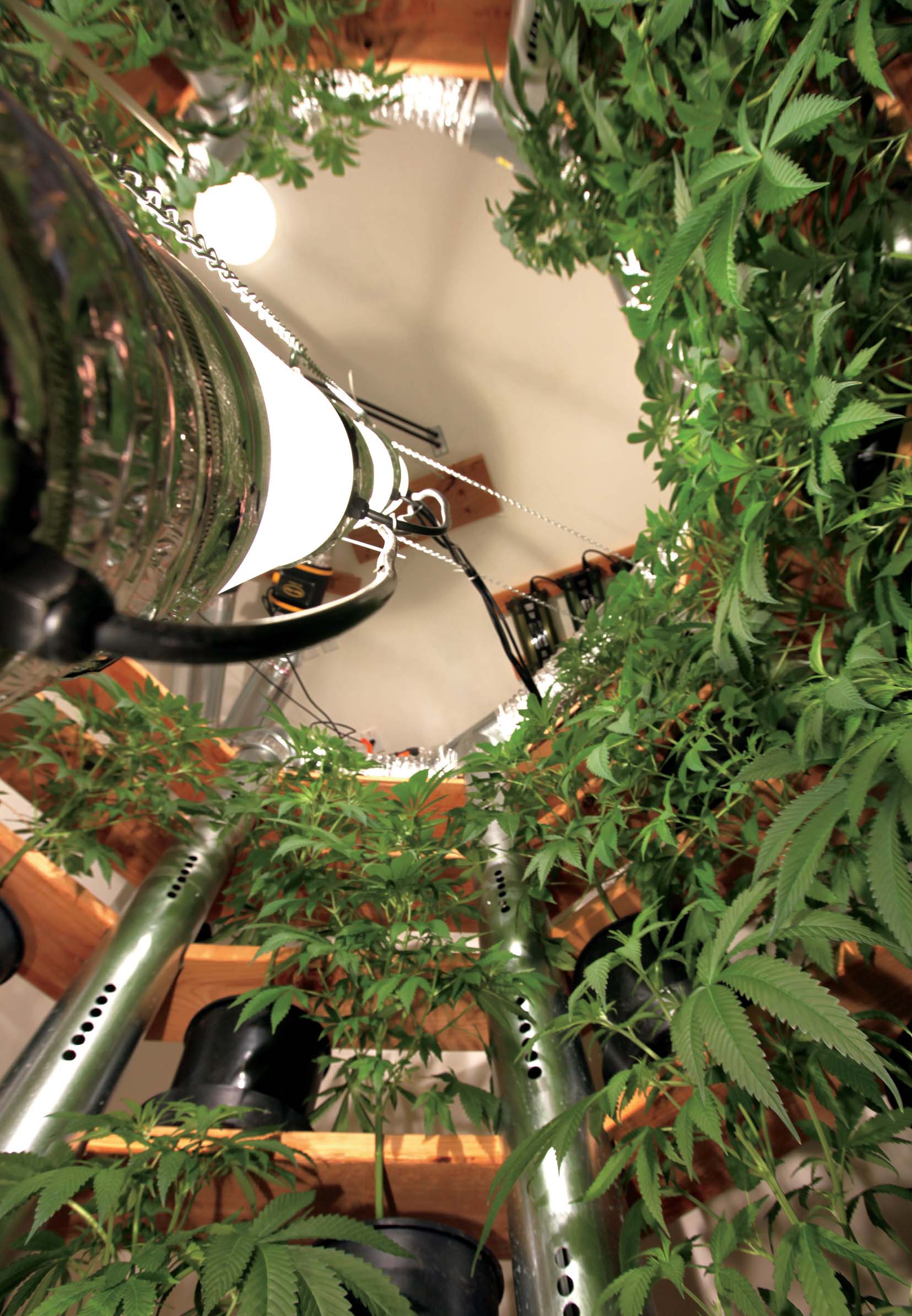
Grow Glide premium racks are designed by cannabis growers for cannabis growers. This vertical racking system optimizes both horizontal and vertical space in the garden that allows indoor growers to truly maximize use of the entire space. Grow Glide racks are set on tracks that easily open up mobile aisles as needed to tend to the plants and optimize workflows. Each tier can be connected to electric and plumbing/watering systems. They are designed to easily run power to every level, and holes drilled into the racks (which are e-coated and powder coated for premium protection) make installing lights a breeze. The low-profile drainage system is easy to clean and optimized for airflow.
VERTICAL GARDENS
Historically, the size of a garden is has been measured by area, or length times width. This has been appropriate for almost the entire history of agriculture because sunlight reaches only the top layer of opaque canopy before it is converted to heat. The understory receives virtually no light.
By contrast, the size of an indoor or greenhouse garden is measured in terms of cubic space rather than area. By developing several levels of gardens, or growing vertically, the space is utilized more efficiently.
There are two different approaches to 3D cultivation: produce a single garden that grows vertically, or create separate horizontal gardens on several levels.
Multi-level gardens are commonly used during certain phases of the growth cycle. Cuttings rooting into clones are frequently grown in 10 by 20 inch (25 by 50 cm) trays placed on steel racks that have three or four shelves, each lit by strip-light LEDs or fluorescent tubes.
Coliseum Structures
“Coliseum” structures, which have declined in popularity due to the shift from HID to LED lights, make excellent use of the omnidirectional light path emanating from the bulbs. With HID lamps, especially in a small garden, much of the light is lost inside the reflector or falls outside the plant canopy. Larger gardens are more efficient but still emit light that is lost.
The Coliseum structure holds containers or rockwool padding on a frame six to eight feet (1.8 x 2.4 m) in diameter. It makes a complete circle when closed, but opens to reveal spaces to plant or attach plants at regular intervals and at heights of about two feet (60 cm).
When the bare lamp is hung inside a Coliseum all the light goes directly to the walls and the floor, which may also hold some plants. The only reflector that might be required is on the top of the lamp to prevent light from drifting up and out.
Coliseum structures are sometimes designed taller, using two lamps, each held vertically at the center.
Stadium Structures
Another version of a multi-level garden features “stadium” structures. Rather than placing the plants in a circle, they are placed on steps, like bleachers in a stadium, that can stretch to a desired length. Each step is about a foot (30 cm) higher than the next. With the steps on either side they form a “V” that can be constructed with up to 10 steps, each about a foot taller than the next. HID lamps are placed in the middle of the V. Two lamps are used for taller stadiums. Lamps are placed on centers close enough to maintain proper light intensity.
Vertical Shelf Gardening
With the use of LED lighting, shelf gardening has become more popular for three reasons, light, heat, and space.
No matter what appliance is used, it produces the same amount of heat per watt. However, HID lamps produce intense light from a small point or line and it must spread out, requiring a three foot (1 m) space between lamp and plant canopy. Some LEDs emit their light over a large area so they are ready to use as emitted, reducing the space between the lamps and the plants.
The light from LEDs is distributed over a wide area, which is preferable to having intense heat that must be dissipated from a small area using HIDs. Much of the LED heat is drained in some units by heat sinks of one kind or another. This allows the lamps to be spaced closer to the plants.
The third reason relates to space, which becomes available with the use of LEDs. Instead of five or six foot (1.5 or 1.8 m) shelves, a shelf from bottom of container to top of light can be just four feet (1.2 m) high. This creates room for multiple shelves.
Lighting and irrigation are easily dealt with. Two important considerations that are more difficult to deal with in all duplex or triplex systems are safety and the different air conditions on each level.
When working above floor level, safety must be primary. How will workers access the plants? How will equipment and tools rise to the appropriate level? Guardrails, secure stairs, to-code dumb waiters and elevators, and non-slip materials are necessary to address safety issues.
Heat rises and humidity accumulates, so each level’s air conditions will differ and so each level must be treated separately. These environmental concerns are best addressed before building or purchasing a system.
With some installations it will be easier to meet code using industrialized systems that have been designed taking both OSHA and air conditions into consideration. A well made system created by professionals could be far cheaper in the long run than a less costly home-made unit.

This is a vertical garden using shelving so that there are four levels of plants. It is lit by two double-ended ceramic metal halide lamps with no reflectors so that the light shines directly on the plants. Photo: Courtesy of Guy Holmes